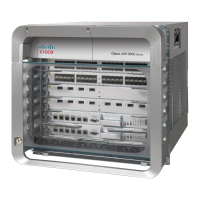70
Cisco ASR 9000 Series Aggregation Services Router Getting Started Guide
OL-28417-02
Chapter Configuring General Router Features
Manually Setting the Router Clock
DETAILED STEPS
Examples
The following example shows how the manual system clock is configured:
RP/0//CPU0:router# configure
RP/0//CPU0:router(config)# clock timezone pst -8
RP/0//CPU0:router(config)# commit
RP/0//CPU0:router(config)# end
Command or Action Purpose
Step 1
configure
Example:
RP/0//CPU0:router# configure
Enters global configuration mode.
Step 2
clock timezone zone hours-offset
Example:
RP/0//CPU0:router(config)# clock timezone pst
-8
Sets the time zone for the router clock.
• clock timezone command should be entered before
the clock is set because it defines the difference
between the system time and UTC.
Note The system time is the time that appears when you
enter the show clock command.
• zone—Name of the time zone to be displayed when
standard time is in effect.
• hours-offset—Difference in hours from UTC.
Step 3
commit
Example:
RP/0//CPU0:router(config-if)# commit
Commits the target configuration to the running
configuration.
Step 4
end
Example:
RP/0//CPU0:router(config-if)# end
Ends the configuration session and returns to EXEC mode.
Step 5
clock set hh:mm:ss dd mm yyyy
Example:
RP/0//CPU0:router# clock set 14:12:00 10 dec
2008
Sets the system software clock.
Step 6
clock update-calendar
Example:
RP/0//CPU0:router# clock update-calendar
Updates the hardware clock (calendar clock) with the new
clock settings.
• It is battery operated and runs continuously, even if the
router is powered off or rebooted.
Step 7
show clock
Example:
RP/0//CPU0:router# show clock
Displays the clock setting.
• Use this command to verify the settings.

